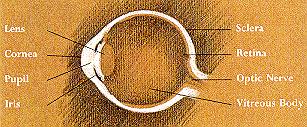

Nineteenth century judges ruling on whether photographs should be admissible evidence frequently analogized the eye to the camera. One of the most peculiar uses of this analogy can be found in scientific theory, widely believed in the mid-1800s.
This theory held that a dying creature, human or animal, would retain the image of whatever it saw in that last moment before he or she expired. This final vision would be fixed, permenently, on the creature's retina. This image, as one lawyer argued, would truly be "a perfect photograph," superior to those fleeting images to which eyewitnesses ordinarily testify. This death-sight, "the handwriting of nature, preserved by nature's camera" would without doubt be admissible evidence in court -- and thus, this lawyer argued, mechanically taken photographs should be admissible as well.
If the last flicker of sight could be captured by the eye, commentators speculated, then was it not possible that the retina of a murder victim might be a dumb witness, and that proof of the murderer could be indisputably revealed by the victim's own body?
Maintained by
jmnookin@bug.village.virginia.edu
URL: http://www2.iath.virginia.edu/ensp982/mnookin/eye.html